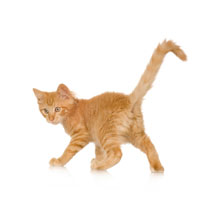How Cats Use Their Posteriors in Friendly Body Language

Cats use practically every part of their body to communicate their intentions and impressions, including their rear ends. That includes their rear ends.
Why Do Cats Raise Their Hindquarters When You Pet Them on Their Lower Backs?
Here are some of the ways and reasons that cats use their rear ends for communication:
- It’s an infantile behavior, a vestige of when they presented that section of their bodies to their mothers for cleaning. Our cats look at us partly as surrogate moms, whether we’re male or female.
- By raising their backsides while being petted, cats exert slight pressure to increase the tactile pleasure from petting.
- Some cats may appreciate—and thus try to get the most of—petting, light fingertip massage, or brushing on their lower backs since that’s a difficult area to reach when grooming.
- The lifting action helps cats spread their scents from their anal sacs, just inside the rectum, onto “petters.”
Cats are often highly sensitive to being scratched near the base of the tail, probably because of the concentration of nerves there. The sensation may be something like being tickled—a little bit of scratching is enjoyable; a lot can be over-stimulating or even painful. Each cat has different responses and tolerance levels for lower back scratching. Note that cats that seem hyper-sensitive or in pain when touched in that area could be suffering from impacted anal sacs, skin allergies, or other conditions requiring veterinary attention.
Note: Be Sensitive to Your Cat’s Sensitivities
All cats are unique in terms of the degree to which they tolerate petting in general and petting in specific regions of their bodies. Learn your cat’s “that’s enough petting” signs, such as fixed stares and vigorous tail-wags, and stop petting or move to a spot for which your cat has greater petting tolerance before reaching that point.
Why, when my cat jumps onto my lap or onto the couch next to me to greet me, does he sometimes stand with his rump in my face?
Part of the standard feline greeting procedure between friends is to allow each party to sniff the others’ anal regions, to gather information. Certainly, you want to be polite when your cat graciously offers you that opportunity . . . but he’ll probably accept some friendly petting and an appreciative “hello” as a substitute for that particular cat protocol.
Why does my cat often position her rear end toward me when she sits on my lap or next to me?
She’s not being rude. She’s showing that she trusts you enough to turn her back on you, which allows her to watch what’s going on in her territory.
You May Also Like These Articles:
Why Do Cats Knock Things Over?
Why Do Cats Purr? The How & Why of Cat Purring
Does Your Cat Have Whisker Fatigue?



